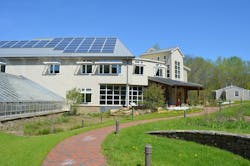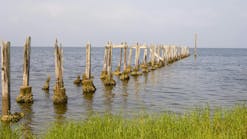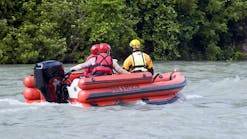Stroud Center cultivates science-based evidence to drive healthy waterways
Stroud Water Research Center (the Stroud Center) started in 1967 as a multidisciplinary field research station to explore threats and solutions to healthy streams and rivers. Today, the Stroud Center continues to advance knowledge and stewardship of freshwater systems through global research, education and watershed restoration. Maintaining its interdisciplinary approach to science incorporating ecology, biology, chemistry, geomorphology, and field earth science, the Stroud Center’s research helps businesses, landowners, policymakers, and individuals make informed decisions that affect water quality and availability around the world.
“One of the unique attributes of the Stroud Center is that we advocate for science-based solutions but do not get involved in politics,” Scott Ensign, vice president of the Stroud Center, said.
Connecting Hydrology & Ecology
The Stroud Center has eight Ph.D. scientists that are leading a variety of research based on evolving questions that impact the health of freshwater systems. These projects involve working with a broad spectrum of experts and agencies including; fisheries, laboratories, entomologists who study aquatic invertebrates, ecosystem ecologists who are looking at how plant and microbial communities cycle nitrogen and phosphorus or break down complex pesticides in the environment, geomorphologists who are studying how rivers and watersheds are shaped, and microbiologists who are studying to understand not just single organisms, but entire communities within their genetic context.
To understand how sediment moves or how pesticides degrade or how groundwater is affected by agriculture, the Stroud Center collects data from multiple sources over long periods of time.
“Monitoring watersheds requires diligence and consistent measurements over decades. Quality assurance and control of this data for easy access to visualize trends and get what we need when we want it, is where Aquarius comes in,” Ensign said.
Aquarius is a software platform that is used by monitoring agencies around the world to acquire, process, model and publish data in real time.
The Stroud Center does a lot of research and large-scale experiments to better understand the link between streams and watersheds by investigating the flow of groundwater and how riparian ecology (plant habitats along the stream) influences the health of streams. For over 50 years, researchers have been monitoring the effects of transforming agricultural land along a riverbank back to its natural state of forest-lined stream. Using Aquarius, researchers can arrange and analyze data and find relationships between such things as sediment flux, dissolved oxygen and discharge of the stream to determine the health of a river.
Importance of Solid Management
There has been a tremendous revolution in the collection of water data in the last 10-15 years. Research centers can collect high-frequency data at a fraction of the cost it used to be, and the end result is a lot of data. The challenge is no longer the collection of data, but rather maximizing the value and use of this information.
“Twenty years ago, it would have taken a huge budget to collect the amount of data we are gathering today. The development of lower-cost data collection systems enables not just professional scientists but citizen scientists and organizations like the Delaware River Watershed Initiative to deploy sensors throughout areas of interest. In collaboration with other partners, we created the Monitor My Watershed Data Sharing Portal which streams data to the web from about 120 sites across the Delaware River basin every five minutes,” said Ensign.
The Stroud Center then pulls this data into Aquarius for quality control, error detection, documenting of changes, and allowing for automatic bias corrections. Alerts can also be configured to warn researchers of unusual events or issues related to the monitoring equipment.
Monitoring the Flow of Salt & Contaminants
A recent discovery that came out of the Delaware River Watershed Initiative was the degree to which road salt moves through the environment – washing into watersheds in the winter and coming up in groundwater in the summer. With so many sensors, placed throughout the community, watershed organizations gained an unprecedented microscopic view of the data which delivered hard evidence on locations where salt application is a problem and where it isn’t. Sharing this information allows communities to advocate for change to protect their watersheds.
The Stroud Center also studies contaminants in watersheds and has partnered with the Center for PFAS Solutions in Delaware to provide data on where PFAS is originating and how it is moving through the environment. Data on the movement of insecticides, such as neonicotinoids is another important area of monitoring as they are commonly used and overapplied resulting in a series of negative effects on ecosystems.
Taking Discoveries into Action
In 2012, the Stroud Center formed the Robin L. Vannote Watershed Restoration Program, a team of six specialized practitioners that work with landowners to share best agricultural practices for protecting healthy river systems. This might be planting riparian forests along the banks or implementing better crop management practices such as cover cropping or reduced tillage.
“Over the last 50 years, we’ve collected data showing that riparian ecology affects the chemistry of the stream, movement of the riverbanks, and the quality of water for species living in it. This is a core reason why our watershed restoration team has such success. We have the proof to demonstrate the solution,” said Ensign.
While methods of collecting data and frequency may change it is vital that the Stroud Center can easily manage and analyze the data to show these broad changes over time and then attribute those changes to processes that can be implemented in real life. This program has also provided the science and programming for a statewide initiative to replant indigenous forests along riverbanks throughout Pennsylvania.
Taking Hydrological Education to New Heights
In the 1990s, the Stroud Center expanded the sharing of its research with K-12 educators, students, researchers, agency personnel and citizen scientists by developing educational resources and providing on-site and remote instruction. The Stroud Center’s Education Department is led by educators and environmental education researchers who ensure that resources and curricula comply with state and federal learning standards. Many of the digital, online learning resources are featured in WikiWatershed and include:
- Model My Watershed - users can analyze geospatial data, model storms and compare watershed conservation and development scenarios.
- Runoff Modulation - users can see how changes in rainfall amount, the surfaces on which the rain falls, and soil texture change where the water goes.
- Monitoring My Watershed - users can discover and map monitoring data from multiple sources. Share and compare your monitoring data with the world.
- Enviro DIY - users join a community of do-it-yourself enthusiasts sharing open-source ideas for environmental science and monitoring.
- Leaf Pack Network - users can discover what aquatic insects can tell you about your stream’s health by performing a simple leaf pack project.
- Leaf Pack Network Simulation - users can run a virtual study to assess stream health via habitat characteristics, macro-invertebrates and chemistry.
- Macroinnvertebrates.org - users can identify common freshwater macroinvertebrates with this resource designed for citizen scientists.
- Water Quality Mobile App - users can enhance stream study and monitoring activities for students and citizen scientists.
These educational programs expanded significantly during the pandemic, as educators were looking online for resources. There are now five full-time people managing the education department with a dozen part-time instructors.
The Stroud Center has successfully expanded on its three pillars – research, education and restoration – using Aquarius to manage and analyze scientific data so researchers and educators can take the data and create meaningful change. The Stroud Center is also a recipient of the Ripple Effect, a software grant from Aquatic Informatics that will enable them to use the new interface as well as the new and modern rating review tool for the rating curves.
“By engaging citizens in learning how the world operates hydrologically, we believe that wherever people go or whatever people choose to do they will be mindful of their impact and have the ability to put their knowledge into practice,” Ensign said.
Intan Distler is technical sales engineer for Aquatic Informatics. Distler can be reached at [email protected].






